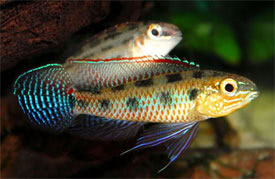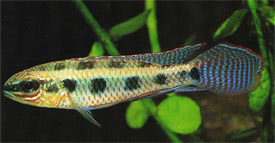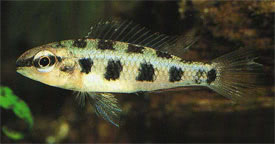
 Magyarul / Hungarian
Magyarul / Hungarian



- Scientific name: Dicrossus maculatus
- Synonyms:Crenicara maculata, Crenicara praetoriusi
- Common name: Spadetailed Checkerboard Cichlid
- Group: Cichlids
- Habitat: South America, Brazil, in the Rio Tapajos, and Rio Maués rivers.
- Size: Male: 9 cm, female: 8 cm
- Biotope: Slow-moving rivers and streams
- Social behavior: Peaceful and shy cichlid, that become territorial during the spawning.
- Diet: Carnivorous, give them only live, and frozen foods; Only small live food is accepted by wild caught fish.
- Breeding: Hard
- Tank: Minimum 75 litres.
- Population: 1 male and 2-3 females for 100 litres
- Decoration: Needs a heavily planted tank with a bottom of fine sand. Add some larger stones and roots, and provide plenty of cover in the form of caves with tiny entrances (coconut shells).
- Temperature: 26-30 °C
- pH: 3.4-5.4
- Hardness: 0-5 NK°
- Lifespan: 5 years
Description: Dicrossus maculatus are not commonly available in the hobby. Sometimes they are mistaken for the more common and popular Dicrossus filamentosus. As an adult, it can be distinguished from Dicrossus filamentosus by its caudal fin: Dicrossus maculatus has lanceolate, while Dicrossus filamentosus has lyrate shaped fin. The fish is basically whitish to silver gray with the patterns of two rows of black spots on the sides of the body. Since Dicrossus filamentosus is yellowish to brown, coloration is the key characteristic for distinguishing females of these two species. To distinguish the sexes, the specimens must be at least half-grown. Males are a little larger than females. Females have less vivid coloration, while males have some striking blue sheen on the side of their heads and gill plates. The female’s ventral fins turn bright yellow during breeding time. The caudal fin of males is slightly lanceolate and bluish with a dense pattern of vertical bands, while that of females is round and always transparent without any design. In males, the soft-rayed section of the dorsal and anal fins is slightly pointed, the ventral fins are elongated into filaments, and all the fins have a bluish iridescent sheen. The soft-rayed section of the dorsal and anal fins of females is rounded, the ventral fins are short, and the fins do not have a bluish sheen.
Dicrossus maculatus are a challenge to breed, because they need very soft, and extremely acidic water for the eggs to hatch. High quality water is also necessary. It has been noted that adding a few small shoaling characins (like tetras) can improve the paternal care that the mature Maculatus display. Under appropriate maintenance conditions, males frequently spawn with several females within the borders of their territory. Females generally attach the eggs to a well-protected leaf or rock or within a cavelike shelter. A large female can produce up to 150 eggs per spawning. Care of the eggs, larvae and juveniles is solely the responsibility of the female, which often lasts for several weeks. Since Dicrossus maculatus is commonly maintained and bred at high temperatures, the fry become free-swimming at a very small size. Consequently, the fry are generally unable to accept Artemia nauplii as an initial food, so smaller live foods must be offered instead. Offspring produced at lower temperatures, on the other hand, are substantially larger and able to feed on Artemia nauplii. Before the fry gets too old they should be given their own aquarium, as they can easily fall prey to other adult fish in the tank. The fry are very sensitive to bad water conditions.
The mother of a brood will use her ventral fins to give commands to her brood. Basically, the extension of her ventral fins will indicate that the fry should come towards her, and the closure of her ventral fins indicate that the fry need to stop. It can be seen when the female herd the fry into a safe place just before they decide to rest for the night. Certain information within the aquarium literature points to the fact that pH has a modifying influence on sex-ratio among the offspring. But while low pHs lead to increased numbers of males in the case of Apistogramma, low pHs are said to result in an elevated number of females for Dicrossus maculatus.


